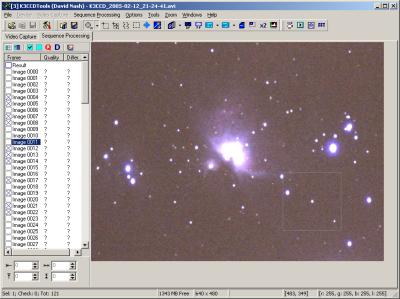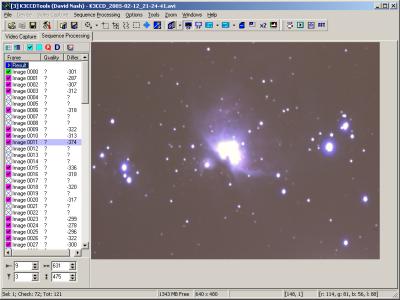3. Alignment and Stacking

|
When you have selected the frames to be used they must be aligned to compensate for any movement between frames. K3CCDTools does this through some feature that you must choose. Click on the FFT Alignment toolbar button to enter alignment mode. When you move the mouse pointer over the image window the cursor will change to a square with a cross hair in the middle.
Move to some suitable well-defined feature and click it when the cross is centred on it. The program will inspect each frame and calculate the movement to align the frames at that point.
|
|
Before stacking, make sure you have loaded the dark frame, if you have one. Click the "DF" button and load the dark frame you saved earlier. The dark frame will be subtracted from each frame in the list, and if you toggle it on and off (by repeatedly clicking the DF button) you will see the hot pixels in the image appear and disappear. If you wish, you can change the method that K3CCDTools uses to cover the subsequent "black holes" by going to the Options dialog.
|
|

|
Now the frames have been aligned and dark frame subtracted, it is time to stack them. Click the stacking button (the one to the left of the DF button) and the process will start. You may wish to save the project at this stage - this will save a special file recording the centre points and frame selections, for later use. The Sequence Processing menu has Save and Load items for this purpose.
|
|
The picture above shows the result of stacking our example pictures. You can immediately see the improvement in the image as a result of the lower noise as compared with the raw frame above. Now save the file in some suitable filename. For the best quality save in TIF16 format, which retains the 16-bit colour information. If you know you are not going do any further processing that can take advantage of that, you can save disk space by saving in BMP format, which is only 8-bits per colour channel, however I usually use the 16-bit TIFF format to preserve the maximum detail in my files.
|
|
|
|
|
 |
|
All text and images copyright and may not be used without permission
|
|
